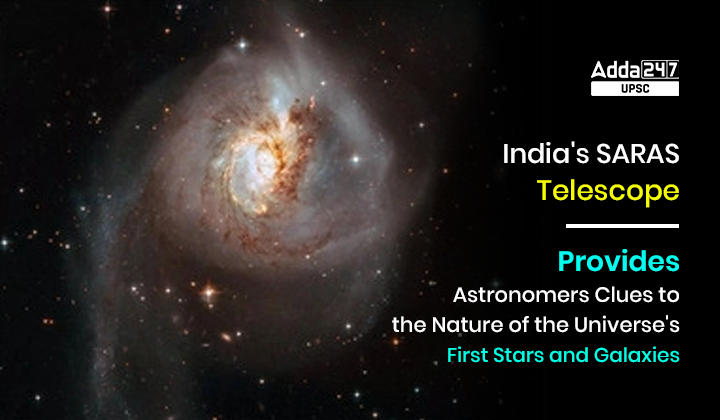Table of Contents
SARAS Telescope UPSC Relevance
India’s SARAS Telescope: India’s SARAS radio telescope has been established to study the galaxy and provide various astronomical findings in the process. SARAS Telescope is important for UPSC Prelims 2023 and UPSC Mains Exam (GS Paper 3- indigenous developments in the field of science and technology).
Liquid-Mirror Telescope- India’s first International Liquid-Mirror Telescope (ILMT)
SARAS Telescope in News
- Recently, India’s SARAS radio telescope provided astronomers clues to the nature of Universe’s first stars and galaxies.
Background of Radio Telescopes
- Scientists have determined properties of radio luminous galaxies formed just 200 million years post the Big Bang, a period known as the Cosmic Dawn.
- This provided an insight to the properties of the earliest radio loud galaxies that are usually powered by supermassive black holes.
- A number of ground and space-based telescopes peering into the sky for a better understanding of the Universe like-
- how the early stars and galaxies formed and
- what they looked like
- This they have tried to find out by capturing the faint signals arising from the depths of the cosmos using various telescopes including radio telescopes.
What is SARAS Telescope?
- Background: The SARAS 3 radio telescope invented and built by the astronomers at RRI is the first telescope worldwide to reach the required sensitivity.
- About: SARAS is a niche high-risk high-gain experimental effort of RRI initiated and led by Prof. Ravi Subrahmanyan, along with Prof. N. Udaya Shankar.
- Objective: SARAS aims to design, build and deploy in India a precision radio telescope to detect extremely faint radio wave signals from the depths of time, from our “Cosmic Dawn” when the first stars and galaxies formed in the early Universe.
- The signal from Cosmic Dawn is expected to arrive on Earth stretched in wavelength to meters and lowered in frequency by the expansion of the Universe to lie in the radio frequency band 50-200 MHz.
- Significance: SARAS 3 has improved our understanding of astrophysics of Cosmic Dawn, telling us that-
- Less than 3 percent of the gaseous matter within early galaxies was converted into stars, and
- The earliest galaxies that were bright in radio emission were also strong in X-rays, which heated the cosmic gas in and around the early galaxies.
Recent Upgrades in SARAS Telescope
- Since its last deployment in March 2020, SARAS 3 has undergone a series of upgrades. These improvements are expected to yield even higher sensitivity towards detecting the 21-cm signal.
- Currently, the SARAS team is assessing several sites in India for its next deployment.
- These sites are fairly secluded and pose several logistical challenges for deployment.
- However, they seem promising from science’s viewpoint and, with new upgrades, seem ideal for experiment.
Recent Applications of SARAS Telescope
- SARAS 3 has improved our understanding of astrophysics of Cosmic Dawn, telling us that Less than 3 percent of the gaseous matter within early galaxies was converted into stars.
- SARAS 3 team used the same data to reject claims of the detection of an anomalous 21-cm signal from Cosmic Dawn made by the EDGES radio telescope developed by researchers from Arizona State University (ASU) and MIT, USA.
- This refusal helped restore confidence in the concordant model of cosmology that was brought into question by the claimed detection.
- Using a phenomenological model, SARAS 3 has been able to put an upper limit to excess radiation at radio wavelengths, lowering existing limits set by the ARCADE and Long Wavelength Array (LWA) experiments in the US.
SARAS Telescope FAQs
- What is SARAS Telescope?
Ans. SARAS is a niche high-risk high-gain experimental effort of RRI initiated and led by Prof. Ravi Subrahmanyan, along with Prof. N. Udaya Shankar.
- What is the objective of SARAS Telescope?
Ans. SARAS aims to design, build and deploy in India a precision radio telescope to detect extremely faint radio wave signals from the depths of time, from our “Cosmic Dawn” when the first stars and galaxies formed in the early Universe.
- What is the significance of SARAS Telescope?
Ans. SARAS 3 has improved our understanding of astrophysics of Cosmic Dawn, telling us that less than 3 percent of the gaseous matter within early galaxies was converted into stars.



 TSPSC Group 1 Question Paper 2024, Downl...
TSPSC Group 1 Question Paper 2024, Downl...
 TSPSC Group 1 Answer key 2024 Out, Downl...
TSPSC Group 1 Answer key 2024 Out, Downl...
 UPSC Prelims 2024 Question Paper, Downlo...
UPSC Prelims 2024 Question Paper, Downlo...
